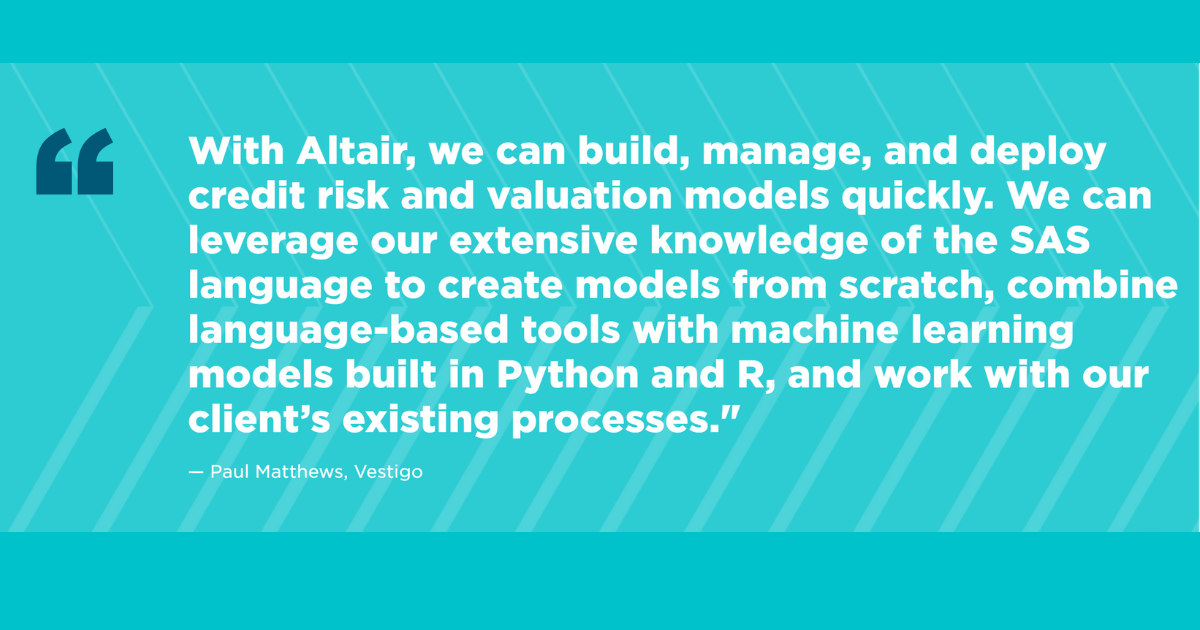

Terms of Use | Privacy Notice | Data Privacy Framework | Cookie Notice | DMCA | Whistleblowing |
© Altair Engineering Inc. All Rights Reserved.

The SAS language has been the undisputed market leader in processing large amounts of data for industry-level statistical analysis. However, other open-source programming languages like Python, R, and SQL have redefined the landscape. While each of these open-source languages has its own sets of pros and cons - many enterprises still rely on a host of business-critical processes that were built on legacy SAS language applications and systems.
The SAS language status quo in banking, insurance, healthcare, and other industries has been tested in recent years. Now is the time for organizations to embrace a future built on agility, scalability, extensibility, and interoperability. Where are you on this journey?
Why Should You Modernize and Future-Proof Your Analytics Technology?
But so is rewriting SAS language applications in an open-source language. In many cases, migration is time-consuming and technically difficult – if not completely impossible. Combining existing SAS code with languages like Python, R, and SQL is equally problematic. To date, the third-party SAS language compilers have been essential for any potential solution, adding additional costs to the equation.
Taking an even wider perspective, analytics strategies must address efficient deployment and effective governance. And organizations must also find ways to utilize the flexibility and scalability of the cloud alongside mobile computing, mainframe, and on-premises infrastructures.
The new wave of code-optional data analytics and ML tools empowers not just specialist programmers and data scientists on your team but a far larger population with different skill sets and disciplines. To maximize your data resources, you must therefore harness the diverse and talented teams that will take hands-on responsibility for making those strategies work.
Utilizing this new wave of hybrid software, you no longer need to grapple with the cost, complexity, and feasibility questions that muddle attempts to translate existing SAS language programs. Instead, you can mix and match the languages that best suit your needs and resources.
Scalability, Reliability, and Manageability
Create, maintain, and run SAS language programs, and explore outputs without additional configuration.
A Single, Unified Application
Use Python, R, Hadoop, and SQL code alongside SAS language modules in a single environment where everyone can collaborate and add significant value.
No Third-party License Requirement
Migrate existing SAS language programs to the hybrid environment.

In this two-part webinar, you’ll learn how to overcome licensing challenges by running critical SAS language programs alongside open-source languages in a single platform, developing end-to-end analytics workflows from siloed data processes, and reducing DevOps bottlenecks with APIs - with technical use-cases.

Their Challenge
Vestigo supports secured and unsecured lenders throughout the credit lifecycle. The firm needed efficient methods for deploying analytics and delivering data-driven insight quickly in various situations for clients varying in size from regional operations to lenders with loan portfolios exceeding $5 billion.
The Solution
Vestigo uses Altair Analytics Workbench™ to develop and maintain models and programs written in the SAS language. The software’s drag-and-drop workflow lets its teams build new models quickly without needing to write any code.
Today’s data analytics modernization strategies must also facilitate the growing demand for faster, more efficient deployment capability. Traditionally, organizations have pushed development code to DevOps or charged analysts with the job of rewriting code for production use. Both approaches are costly in terms of time, skills, and resources.
In a nutshell: with the new hybrid mix-and-match language environment, everyone on your team can create better data analytics outcomes.